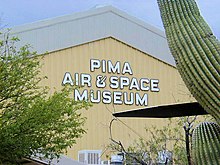Pima Air & Space Museum
This article needs additional citations for verification. (August 2015) |
 The main entrance to the museum | |
 Location in Arizona | |
| Established | May 8, 1976 |
|---|---|
| Location | 6000 East Valencia Road Tucson, Arizona, United States |
| Coordinates | 32°08′20.2″N 110°52′07.3″W / 32.138944°N 110.868694°WCoordinates: 32°08′20.2″N 110°52′07.3″W / 32.138944°N 110.868694°W |
| Type | Aviation museum |
| Director | Scott Marchand |
| Website | pimaair |



The Pima Air & Space Museum, located in Tucson, Arizona, is one of the world's largest non-government funded aerospace museums. The museum features a display of nearly 300 aircraft spread out over 80 acres (320,000 m²) on a campus occupying 127 acres (513,000 m²). It has also been the home to the Arizona Aviation Hall of Fame since 1991.
Overview[]
A large number of the museum's aircraft are displayed outside with the remainder located in one of the museum's four display hangars.[1] In addition to the display hangars, the museum has a restoration hangar.[2]
Opened to the public in May 1976 with 48 aircraft then on display, the Museum's main hangar houses an SR-71A Blackbird, an A-10 Warthog, a United States Air Force Through the Years exhibit, and a mock-up of a control tower.
The museum is adjacent to Davis-Monthan Air Force Base. The 309th Aerospace Maintenance and Regeneration Group (AMARG), affiliated with the base, also known as the "Graveyard of Planes" or "The Boneyard", is the largest aircraft storage and preservation facility in the world.[3]
History[]
The museum opened to the public on May 8, 1976. In early 1982 the first hangar on the site was completed. A second was built in 1987, a third in 1992, and a fourth in 1994.[1]
In 2012, the museum collaborated with artists, in The Boneyard Project, to place some abandoned aircraft on display as canvases for art.[4][5]
During 2015, Boeing donated to the museum the second 787 aircraft to be built. It is exhibited in the colors of the 787 customer, ANA.[6]
In November 2016, Orbis International donated their first McDonnell-Douglas DC-10 Flying Eye Hospital to the museum, after receiving a second DC-10 from FedEx. The DC-10, which was the oldest flying example of its type and at the time of its donation, while being the oldest surviving example and the second overall built, was restored for display at Davis–Monthan Air Force Base.[7]
The museum acquired 77 acres in January 2021 for the construction of the Tucson Military Vehicle Museum. The new museum will house a large number of mostly land vehicles, including 50 donated by the Imperial War Museum.[8]
Selected aircraft on display[]

Out of a collection of 300 aircraft, these are the most prominent:[1]
- The Boeing 777 prototype, B-HNL.[9]
- Boeing B-17 Flying Fortress "'I'll Be Around" (replica).[10]
- Boeing B-29 Superfortress "Sentimental Journey" [11]
- Consolidated B-24 Liberator "Bungay Buckaroo" [12]
- Convair B-36J Peacemaker "City of Fort Worth", the last B-36 ever built and the last to serve in the USAF.[13]
- English Electric Lightning[14]
- Lockheed SR-71 Blackbird[14]
- Martin PBM Mariner[14]
- North American F-107 one of 3 built and 2 still in existence.[14]
- Aero Spacelines Super Guppy
- The Boeing 747-100 General Electric engine testbed, N747GE
- The 2nd Boeing 787 prototype, N787EX
- The very last Convair B-58 Hustler ever built
- The original Orbis International Flying Eye Hospital Douglas DC-10 N220AU, also the 2nd DC-10 ever built, and the oldest in existence
See also[]
- List of aerospace museums
- Pinal Airpark
References[]
- ^ Jump up to: a b c Stemm, James. "History of the Pima Air & Space Museum". Pima Air & Space Museum. Pimaair.org. Retrieved May 12, 2017.
- ^ "Restoration Hanger & Project Status". Pima Air & Space Museum. Archived from the original on February 8, 2014. Retrieved May 14, 2017.
- ^ ""Boneyard"/AMARG Tour". Pima Air & Space Museum. Pimaair.org. Retrieved May 15, 2017.
- ^ Firestone, Eric (2012). "[Homepage]". The Boneyard Project: Return Trip. Retrieved May 15, 2017.
- ^ Francis, Christopher (2013). "Plane becomes canvas at Pima Air & Space Museum". Tucson News Now. Raycom Media. Retrieved May 15, 2017.
- ^ "Boeing donates 787-8 ZA002 (N787EX) to the Pima Air and Space Museum". World Airline News. Retrieved August 26, 2015.
- ^ Wilson, William. "Pima Space Museum to get DC-10 that served as flying eye hospital". Arizona Daily Star. Retrieved November 20, 2018.
- ^ "Expansion of the Pima Air and Space Museum with the Tucson Military Vehicle Museum" (PDF). Pima County. January 26, 2021. Retrieved February 4, 2021.
- ^ "First Boeing 777 now at Pima Air and Space Museum". News for Tucson. September 18, 2018. Retrieved February 4, 2021.
- ^ "390th Memorial Museum". Pima Air & Space Museum. Archived from the original on February 8, 2014. Retrieved May 15, 2017.
- ^ "Hanger 4". Pima Air & Space Museum. Archived from the original on February 8, 2014. Retrieved May 15, 2017.
- ^ "Hanger 3". Pima Air & Space Museum. Archived from the original on February 8, 2014. Retrieved May 15, 2017.
- ^ "Airframe Dossier 52-2827 USAF B-36J". Aerial Visuals - Airframe Dossier. June 2, 2021. Retrieved June 2, 2021.
- ^ Jump up to: a b c d "Hanger 1 South The Spirit of Freedom Hanger". Pima Air & Space Museum. Archived from the original on February 8, 2014. Retrieved May 15, 2017.
External links[]
| Wikimedia Commons has media related to Pima Air & Space Museum. |
- Official website

- The Boneyard Project, Eric Firestone Gallery, Tucson. Includes narrated video/slide show.
- U.S. Geological Survey Geographic Names Information System: Pima Air Museum
- Aerospace museums in Arizona
- Culture of Tucson, Arizona
- Buildings and structures in Tucson, Arizona
- Museums in Tucson, Arizona
- Landmarks in Tucson, Arizona
- Military and war museums in Arizona
- Aviation halls of fame
- Museums established in 1976
- 1976 establishments in Arizona
